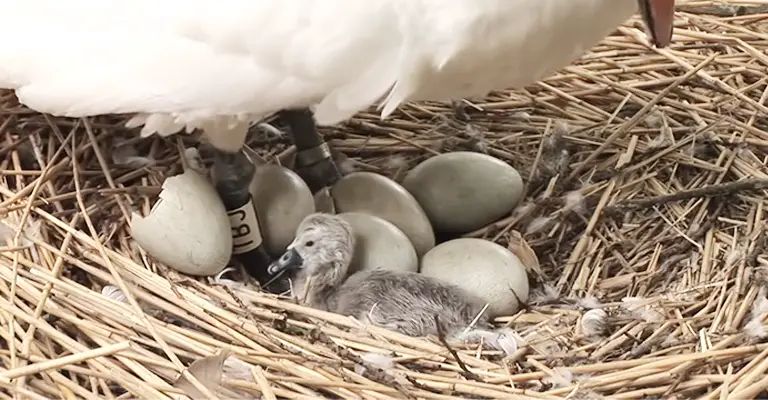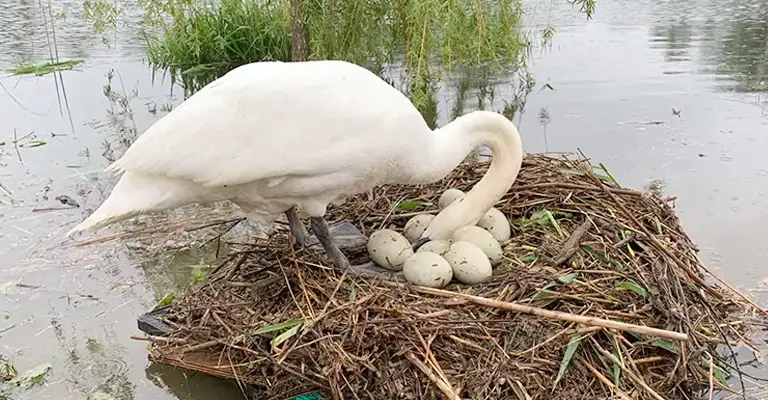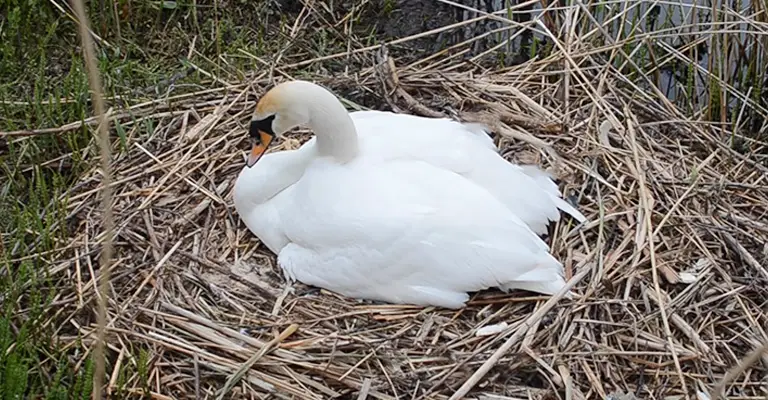The fascinating world of swans, with their elegant grace and tranquil presence, includes a remarkable aspect of their life cycle the incubation and hatching of their eggs.
One of the most enchanting moments in the life of a swan family is the emergence of cygnets from their eggs. Understanding the duration of this process is not only a matter of curiosity but also holds ecological significance.
Swan eggs, like those of many bird species, follow a specific timeline in their journey to hatching. While the exact duration can vary depending on factors such as species and environmental conditions, it generally falls within a specific range.
In this exploration, we delve into the question: “How long do swan eggs take to hatch?” By shedding light on this natural wonder, we gain insight into the world of these majestic birds and their commitment to the next generation.

How Long Do Swan Eggs Take To Hatch?
Swan eggs typically take around 35 to 42 days to hatch. The exact incubation period can vary depending on factors such as the swan species and environmental conditions.
Mute swans, for example, generally have an incubation period of about 35 to 38 days, while Trumpeter swans may require up to 42 days.
During this incubation period, the female swan, known as the pen, diligently sits on the eggs to keep them warm and protect them from potential threats.
Once the eggs hatch, cygnets, or baby swans, emerge, and they are initially dependent on their parents for warmth, protection, and nourishment.
The hatching process is a crucial and fascinating stage in the life cycle of swans, marking the beginning of their journey into the world.
What Happens If Swan Eggs Don’t Hatch?

Here’s what happens if swan eggs don’t hatch:
Loss of Offspring
If swan eggs do not hatch, the most direct consequence is the loss of potential offspring. This disrupts the natural life cycle of swans and reduces the population of the species.
Wasted Energy and Resources
The parent swans invest a significant amount of energy and resources in incubating the eggs. If the eggs do not hatch, this investment goes to waste, impacting the energy levels of the parents and potentially affecting their ability to care for future offspring.
Disruption of Social Bonds
Swans, especially those in monogamous relationships, form strong social bonds during the breeding and nesting period.
Failed hatching can lead to emotional stress and disrupt these bonds, potentially impacting future mating attempts and the overall social structure of the swan community.
Reduced Genetic Diversity
Each clutch of eggs represents a unique combination of genetic material from the parent swans. Failed hatching reduces the opportunity for genetic diversity within the population, potentially making the species more susceptible to diseases and environmental changes.
Impact on Ecosystem Balance
Swans play a role in shaping their ecosystem by controlling aquatic vegetation and supporting various other species through their activities.
A decrease in the swan population due to unsuccessful hatching could disrupt these ecological balances, leading to overgrowth of certain plants and negatively affecting other organisms in the ecosystem.
Potential Reasons for Failure
Failed hatching might indicate environmental issues such as pollution, habitat loss, or climate change, which can impact the health and reproductive success of swans.
Monitoring the hatching success can serve as an indicator of the overall health of the ecosystem.
Educational and Conservation Concerns
For conservationists and researchers studying swan populations, unsuccessful hatching can provide valuable insights into the challenges faced by the species.
It underscores the need for conservation efforts, habitat restoration, and education to ensure the survival of swans and their habitats.
Understanding the consequences of failed hatching is vital for conservationists, ecologists, and communities living near swan habitats.
It emphasizes the importance of preserving natural habitats and ensuring the well-being of these graceful and ecologically significant birds.
What Do Swans Do To Hatch Their Eggs?

Swans engage in several specific behaviors and actions to hatch their eggs successfully. Here are some key steps involved in the process:
Nesting
wans begin by selecting a suitable nesting site, often near water, where they build a nest made of reeds, grass, and other available materials.
The female swan, known as the pen, carefully constructs the nest, ensuring it provides a secure and comfortable environment for the eggs.
Egg Laying
Once the nest is prepared, the female swan lays her eggs, typically one at a time, with a gap of a day or more between each egg. The number of eggs in a clutch can vary but often ranges from 3 to 9, depending on the swan species.
Incubation
After the last egg is laid, the pen begins the incubation process. She sits on the nest to keep the eggs warm and turns them regularly to ensure even temperature distribution.
The male swan, called the cob, may also help by standing guard and providing protection.
Regulating Temperature
Maintaining a consistent temperature is crucial for egg development. The pen uses her body heat to keep the eggs warm, ensuring they do not get too cold or too hot.
Her brood patch, a featherless area on her lower abdomen, makes direct contact with the eggs, facilitating heat transfer.
Turning Eggs
The pen rotates or turns the eggs to prevent the embryos from sticking to the inner membrane and to facilitate even development. This action ensures that all parts of the developing embryos receive equal nourishment.
Protecting the Nest
Both the pen and the cob work together to protect the nest and eggs from potential threats, including predators and human interference. They may exhibit defensive behaviors, such as hissing, posturing, or even physical confrontations to deter intruders.
Hatching and Care of Cygnets
After the incubation period, which typically lasts around 35 to 42 days, the eggs begin to hatch. The pen and the cob are highly attentive to the hatching process, assisting the cygnets in breaking through the eggshells.
Once hatched, the parents provide warmth, protection, and food for the newly hatched cygnets, helping them to grow and thrive.
Swans’ commitment to nurturing their eggs and raising their young is a remarkable and intricate process that contributes to the survival and well-being of their species.
These actions showcase the dedication and parental care swans invest in their offspring.
FAQs
How long does it take for swan eggs to hatch?
The incubation period for swan eggs typically ranges from 35 to 42 days. However, the exact duration can vary depending on factors such as the swan species and environmental conditions.
Mute swans, for instance, usually hatch their eggs in about 35 to 38 days, while Trumpeter swans may take up to 42 days.
What role do the parent swans play during the incubation period?
During incubation, the female swan, or pen, is primarily responsible for keeping the eggs warm. She turns the eggs regularly to ensure even temperature distribution.
The male swan, or cob, may assist by providing protection and standing guard over the nest.
What happens if swan eggs do not hatch within the expected timeframe?
If swan eggs do not hatch as expected, it may indicate issues with the eggs or environmental conditions. The parents may abandon the nest and reattempt breeding if the eggs prove unviable.
How important is the incubation period for swans’ survival?
The incubation period is crucial for the survival of swan populations. It ensures the development of healthy cygnets and contributes to maintaining the ecological balance within their habitats.
Are there any conservation concerns related to swan egg hatching times?
Yes, monitoring swan egg-hatching success can provide valuable insights into the health of both swan populations and their ecosystems. A decrease in hatching success can indicate environmental issues, prompting conservation efforts and habitat restoration to safeguard these majestic birds.
Conclusion
In the serene world of swans, the journey from egg to cygnet is a captivating process that encapsulates the dedication of these magnificent birds to their offspring.
The question, “How long do swan eggs take to hatch?” reveals not only the precise timing but also the intricate mechanisms of nature.
Typically, the period of incubation lasts around 35 to 42 days, although this can vary with swan species and environmental conditions.
This duration is marked by the ceaseless care and vigilance of the parent swans, ensuring that their eggs develop into healthy cygnets.
The hatching of swan eggs is a symbol of renewal, a testament to nature’s timeless cycle, and a reminder of the delicate balance that sustains our ecosystems.
By appreciating the beauty and significance of this process, we gain a deeper connection to the enchanting world of swans and a renewed sense of awe for the wonders of the natural world.